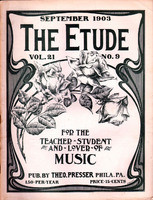E. P.—Seconds, thirds, sixths, and sevenths are distinguished by the terms Major and Minor, “greater” and “less,” because the intervals of that value that occur in the scale are not of the same value, as regards the number of semitones they contain. For example: The Second from C to D is greater than the one from E to F; the Third from C to D greater than the one from D to F; the Sixth from D to B greater than the one from E to C. The language of scholars when the terms of music were fixed was Latin; hence the terms Major (meaning greater) and Minor (less) were applied to intervals that occur between members of the same scale which varied in the number of tones or semitones contained. All octaves that occur are alike, all fifths and fourths that were accepted by the composers and theorists who first determined musical science were alike; hence the use of the term Perfect. Seconds, thirds, sixths, and sevenths occurring between members of the same scale are not identical in point of contents; hence the use of Major and Minor.
L. V.—1. Macdowell’s “Scottish Tone Picture” has a peculiar rhythmic combination, as you suggest, namely: The time signature in the part to which you refer is 6/8 - The right hand has six sixteenths to play to one count; the left-hand passage for the same beat consists of four eighth notes, marked 4. This is exactly similar in idea to the more common group of two eighth notes in 6/8 time, the group marked 2. The grouping as used by Mr. Macdowell means that the four eighth notes are to be played in the time of one beat, or in the same time as the six sixteenths in the right hand. It is not possible to indicate the exact moment when each note is to be played. The first notes of the upper and lower groups are played simultaneously; the following diagram may aid as to the other notes:
 2. In order to tell the key of a piece or a passage in the minor mode, find the tonic chord. If the piece begins in the minor mode usually the first chord in the first full measure is the tonic chord. Another aid is to see if the tonic chord you feel corresponds with a chord on the sixth degree of the major scale indicated by the signature. Thus: Signature, one sharp, G major; sixth degree is E; the chord E, G, B, is the tonic chord. If the piece is in minor the final chord must be the tonic; the bass note of that chord is the keynote. If you have not studied harmony, begin at once. You cannot get short cuts from others who have studied theory. You will be able to help yourself if you will study the subject. The question you ask is but one of a hundred that are answered in any good text-book.
2. In order to tell the key of a piece or a passage in the minor mode, find the tonic chord. If the piece begins in the minor mode usually the first chord in the first full measure is the tonic chord. Another aid is to see if the tonic chord you feel corresponds with a chord on the sixth degree of the major scale indicated by the signature. Thus: Signature, one sharp, G major; sixth degree is E; the chord E, G, B, is the tonic chord. If the piece is in minor the final chord must be the tonic; the bass note of that chord is the keynote. If you have not studied harmony, begin at once. You cannot get short cuts from others who have studied theory. You will be able to help yourself if you will study the subject. The question you ask is but one of a hundred that are answered in any good text-book.
S. S.—The question of learning to sing from notes at sight is not properly a subject for The Etude Study Club, and it is not likely that we shall take it up. At any rate it is not in the lessons planned for the present year. If you wish to get up a class write to the publisher of The Etude for a list of suitable text-books.
K. R.—1. Use Mathews’ “Standard Graded Course” for the piano with your pupils who have finished their first instruction book. This course comes in ten grades. If you will tell us what instruction book you use, we will advise you which grade to commence with. For your little pupils we suggest “First Steps in Pianoforte Playing,” which gives a fine selection of exercises and melodious pieces. The publisher of The Etude will make up a selection of easy studies from which you can select those you wish to use. Write to him for information as to the plan of sending music on selection.
2. Get Tapper’s “First Studies in Music Biography” and Fillmore’s “History of Music.”



